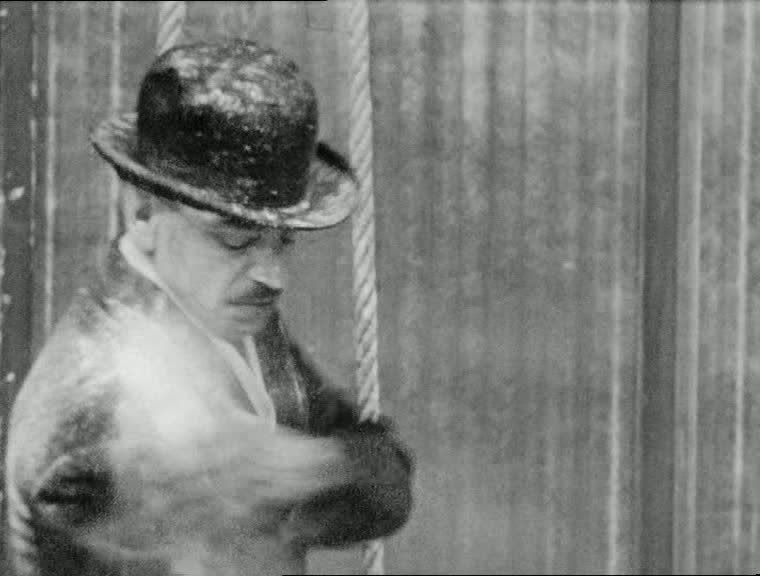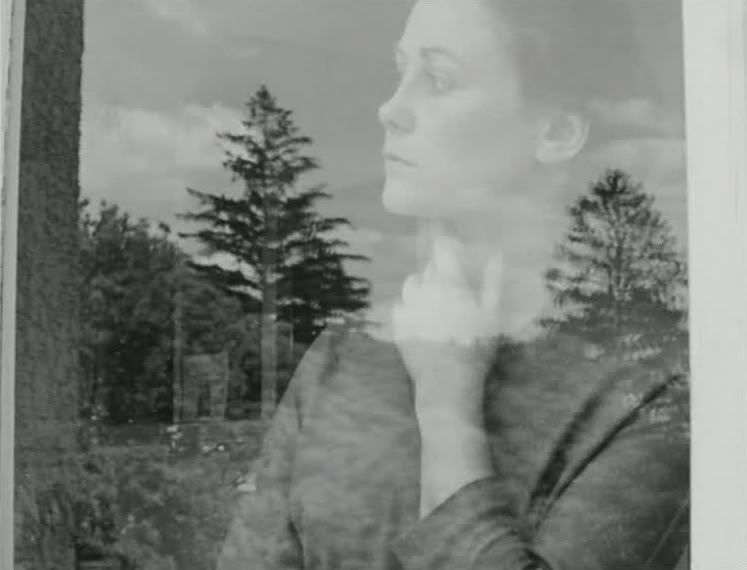
The early work of a director is often an instructive glimpse into the development of the sensibility that would go on to inform his or her mature works, suggesting the auteur's concerns and style in nascent form. With the early shorts and documentaries of the French master Maurice Pialat, it's more the case that these experiments and sketches suggest various paths not traveled in his later work. These rough amateur works only rarely display traces of the emotionally explosive, improvisational sensibility that would characterize Pialat's later work. There's a diversity of styles and concerns on display here, suggesting a young filmmaker trying out anything he could think of while trying to discover his own style.
Pialat's first film was the 8-minute short Isabelle aux Dombes, shot in 1951 when the director was 26 years old. The film is an entirely silent montage of documentary footage, ragged experimental techniques — mainly some negative-image inserts — and symbolic psychodrama that's surprisingly not too different from the work that Stan Brakhage would begin making just a year or two later. A car speeds through the countryside. A horse chews amiably in closeup while a thick carpet of flies crawls and flutters all over its face, even clustering around its eyes. A bird flies backward, the image reversed, and then Pialat cuts abruptly to an image of a dead bird hanging from a power line.
Images of death proliferate throughout the film, and what started as a loose documentary soon becomes an eerie psuedo-horror piece that's obsessed with death and decay. The woman seen as a car passenger at the beginning of the film is soon stalked by a mysterious man, chasing her in negative-image, and then she reappears as an avatar of death in a black robe, her figure reflected in a wavering pool of water. In blurry, creepy images, her eyes are scarred over by tissue that blinds her, her lips moving silently, repeating some incantation. By the end of the film, she resembles Charon, rowing across the river Styx, an avatar of death. The film is vague and mysterious in its meaning, simply evoking a creepy atmosphere through the grim, stark images and the way Pialat jams them together through his choppy editing.

Maurice Pialat's second film was the relatively straightforward documentary Congrès eucharistique diocésain, very different in tone and style from his bleak, jarring first film. The film consists entirely of documentary footage shot at a small-town religious festival, with occasional cutaways to observe the rolling hills and flowers of the surrounding country. Pialat's montage is loose and free-associative, mixing together snippets of various ceremonies and sacraments with these natural interludes as well as more off-the-cuff moments in which people stand around, chatting and laughing. These latter images are the most suggestive of later Pialat, already reflecting his interest in what happens outside the officially sanctioned moments, when ostensibly nothing is happening and people are just exchanging idle pleasantries and gossip.
The editing too is striking, with the same choppy fast pace and free-associative rhythms that characterized Isabelle aux Dombes, though not used to the same disorienting effect. The repetitions and cuts here are gentler, just creating a unified portrait of events and little moments going on at various points during this ceremony.

The biggest surprise of Maurice Pialat's early work is the 1957 short Drôles de bobines, a goofy tribute to silent comedy, complete with old-timey jazz score, intertitles, and slightly sped-up movement. It's quite possibly the last thing one would expect from Pialat, a thoroughly silly romp with plenty of broad physical comedy, and lots of people running around, throwing themselves in front of cars, performing pratfalls. It features an ever-expanding cast of stereotypes and caricatures: a hapless old lady, a foppish upper-class snob, an Arab dignitary with a turban, a priest. It starts out pretty dire and boring, but the more manic and crowded it becomes, the more it starts to display a weirdly warped sense of humor that has the old lady fencing with a painter, the Arab spitting his drink in the old lady's face, the priest getting stabbed in the ass while delivering a sermon, and multiple people continually coming close to running off the roof of a building in the course of their frenetic racing about.
It's nonsensical and slight, but it winds up being a pretty lively and clever tribute to silent-era comedy, Pialat nodding to an influence that doesn't especially show up in his later work but nonetheless must have been an important point of reference in his early love of the cinema, much as it was for the filmmaker-critics of the somewhat younger Cahiers du cinema generation.

L'ombre familière is the first really interesting film that Maurice Pialat made in his early career. This creepy, strikingly composed short is a ghost story without an actual ghost, an eerie film about death, love and creativity set to a droning sci-fi score. The wife (Sophie Marin) of the painter Robert (Jacques Portet) is deeply shaken up by a visit from Robert's filmmaker friend Alexandre (Jean-loup Reinhold), who stays in their country home for a day, wanders around a deserted pool in the forest with the couple, and then returns to the city to commit suicide.
The short's narrative is conveyed through voiceover rather than dialogue, which was also a common trick of the early French New Wave shorts to get around the inability of these young filmmakers to shoot with synchronized sound. With its rambling, poetic narration and elliptical, at times almost abstract, narrative, this short recalls the work of Alain Resnais or the early shorts of Jean-Luc Godard, and though it's very different from the work Pialat would go on to do, it's very compelling in its own right. Perhaps most interesting is the implication that filmmaking, and creativity in general, is a dangerous act that can involve probing to the core of emotions better left undisturbed — an apt description for Pialat's own intense, draining process in his mature work.
The film is replete with images of reflections: Robert and Alexandre facing one another from opposite sides of a glass divider, one reciting lines and one directing, two aspects of the creative process cut off from one another and yet joined together, overlaid, within the glass, which serves like a projection screen on which their images, their shadows, can interact. Thus film both divides and brings together, cuts people apart and creates something new from their combination. But at the same time there's an element of willful erasure in creativity, as well. At the end of the film, the wife's voiceover discusses creating a film set in the abandoned pool, not as a way of remembering the friend they'd spent a day with there, but as a way of forgetting him, of transmuting whatever passed between them, the strange love triangle and the recrimination over his death, into an artistic statement that's ultimately separated from the real intensity of those memories.
No comments:
Post a Comment